Underfloor heating association highlights assessment issues

Underfloor heatingin a better light — Rex Ingram
The capabilities of underfloor heating for delivering comfort using less energy than other forms of heating are increasingly being recognised — especially with the latest Building Regulations requiring new buildings to have a carbon footprint around 25% less than a similar building designed to the 2002 Building Regulations. Verification that newly designed buildings comply with this requirement requires checking the design with SBEM for commercial and industrial building and SAP for residential buildings — or with accredited simulation software. ‘Unfortunately,’ says Rex Ingram, chairman of the Underfloor Heating Manufacturers’ Association, ‘SAP ratings and SBEM and iSBEM modelling do not always give a fair picture of the undoubted carbon-reducing benefits of underfloor heating. Other programmes such as the long-established TAS and IES systems do not seem to suffer from this problem.’ If experience gained from many underfloor heating projects over at least the last 10 years is to be a useful basis for designing buildings with smaller carbon footprints, there are serious issues to be addressed. Not only are the energy-saving benefits of underfloor heating using even conventional boiler plant in danger of being excluded from designs for new buildings, but so too are the much greater benefits of exploiting renewable energy using heat pumps. Part of the problem, believes Rex Ingram, is that SBEM is a simplistic approach to evaluating the energy performance of a building design and has not been tested against any of the accreditation procedures. In contrast simulation software such as TAS and IES have been used for some 20 years and been subjected to extensive testing and evaluation. They have also been accredited for evaluating designs to Part L. Rex Ingram suggests that one reason for the wide discrepancies between analyses carried out using SBEM and simulation software that have been presented at recent seminars is that simulation software models building performance hour by hour and day by day. SBEM, on the other hand, works to longer timescales — which can make an enormous difference to the results. Since the process of achieving planning permission involves using SAP, SBEM or accredited simulation software, the choice could be significant. Indeed, Rex Ingram suggests that the cost of a building-simulation package could be dwarfed by the savings made possible in just one building and its services compared with using the free-issue SBEM. In addition, UHMA and EURAY (the European association for underfloor heating) have arranged for studies by independent test houses in Denmark, Italy and Germany to compare the performance of underfloor heating with warm air and radiators in three standard types of buildings. The results are showing that underfloor heating is more efficient than the other two methods. Rex Ingram tells us that this evidence will be presented to BRE, which is responsible for the development of SBEM and SAP, so that the algorithms used can be adjusted. ‘Demand for underfloor heating in the UK is at an all-time high,’ says Rex Ingram. ‘The recently revised Part L of the Building Regulations makes it essential that the energy consumption and environmental impact of the heating system for any building is considered from the very earliest planning stage.’
Related links:


